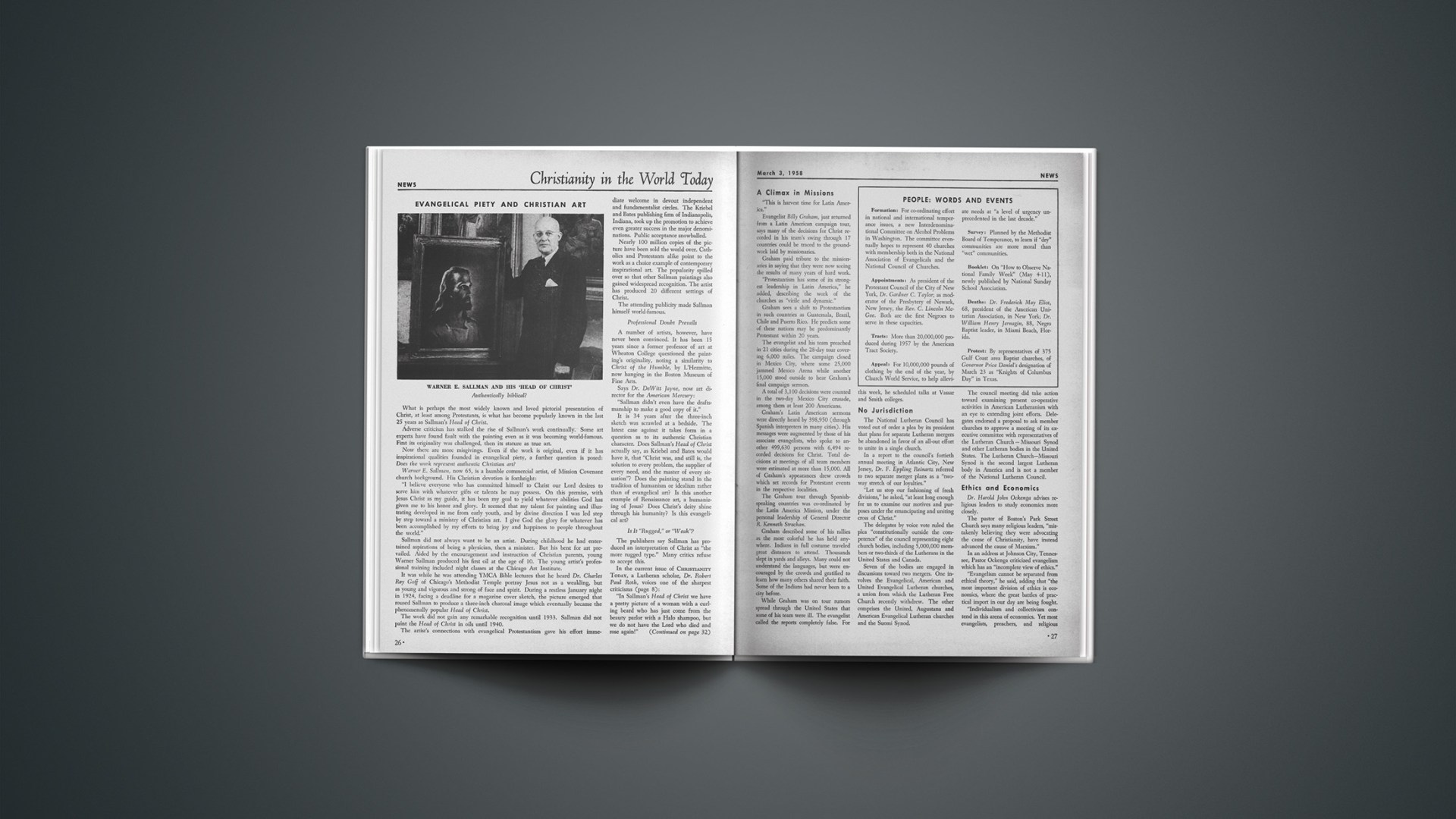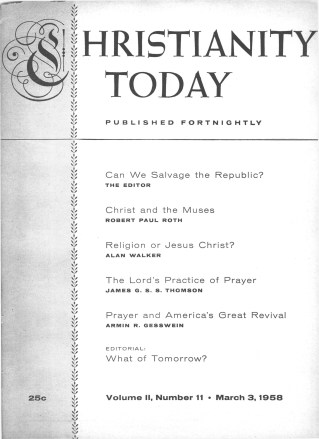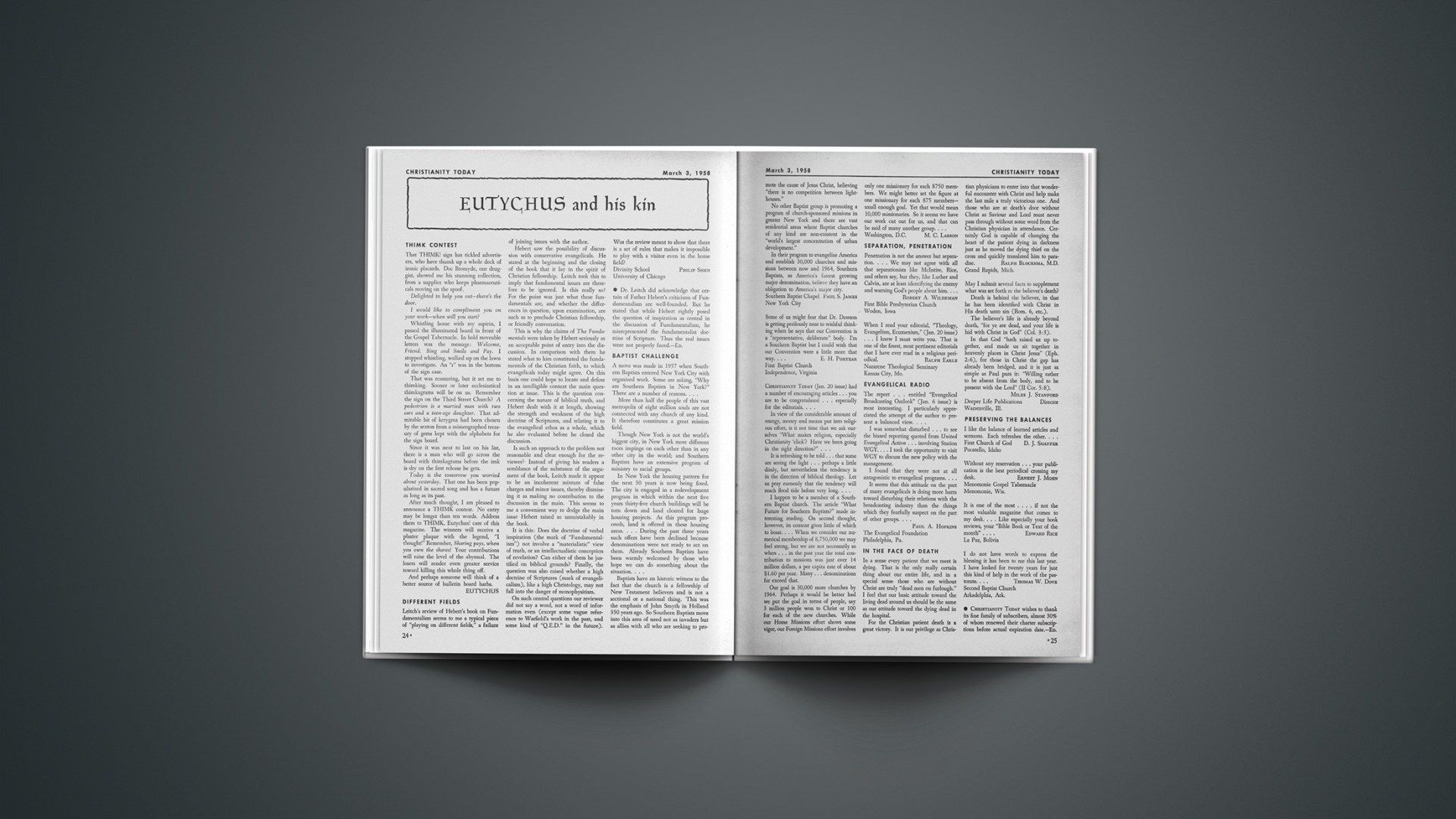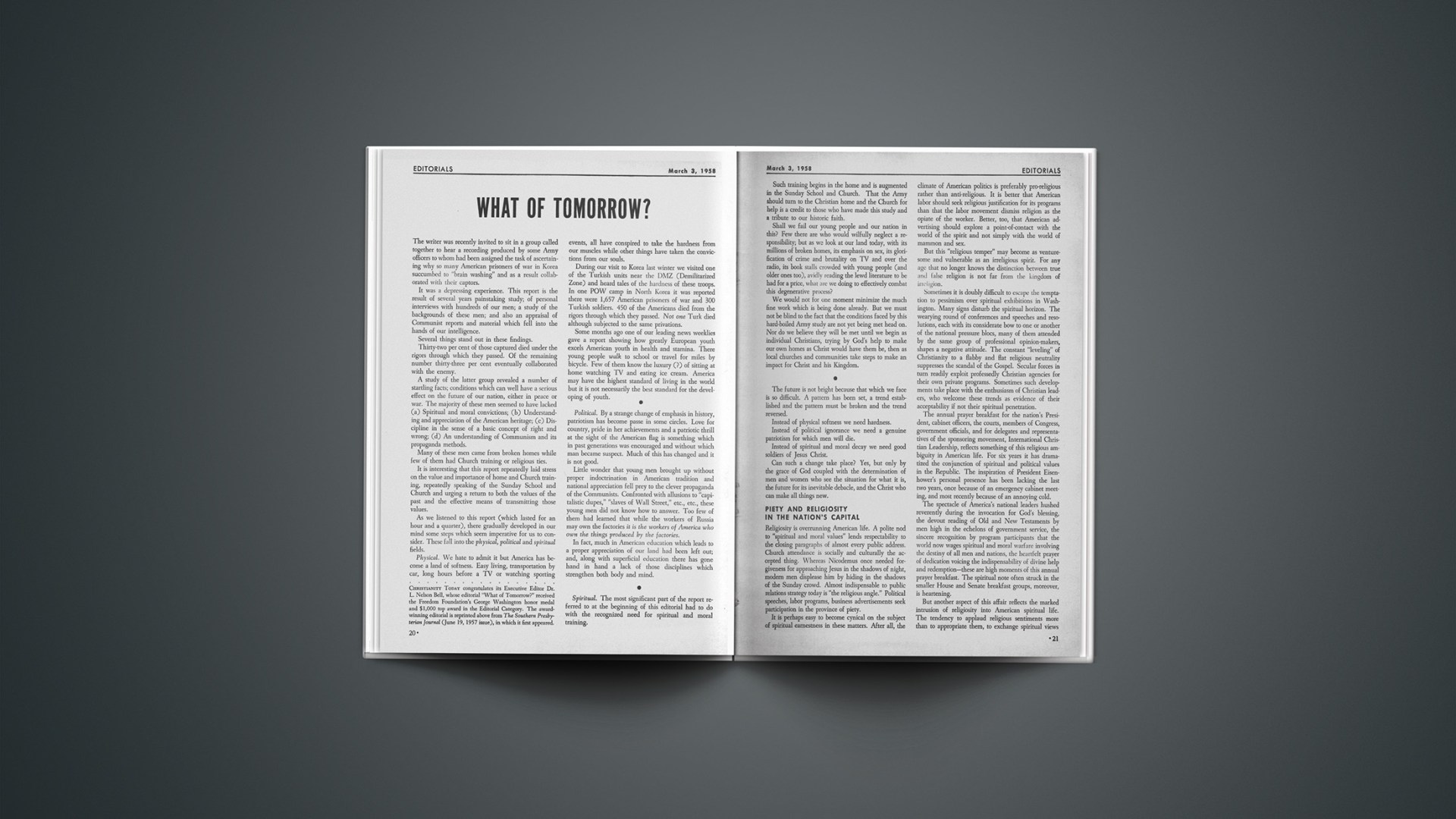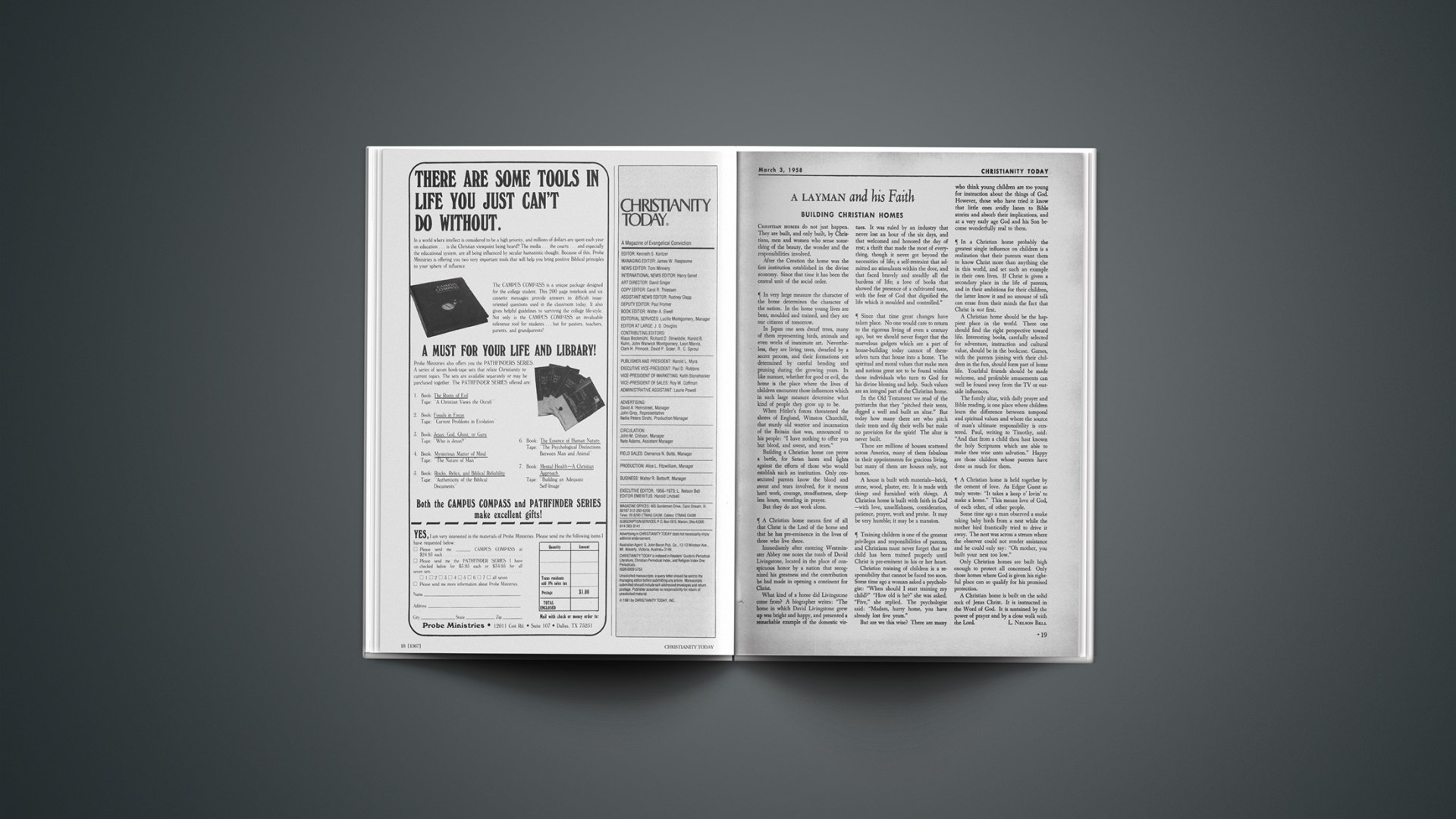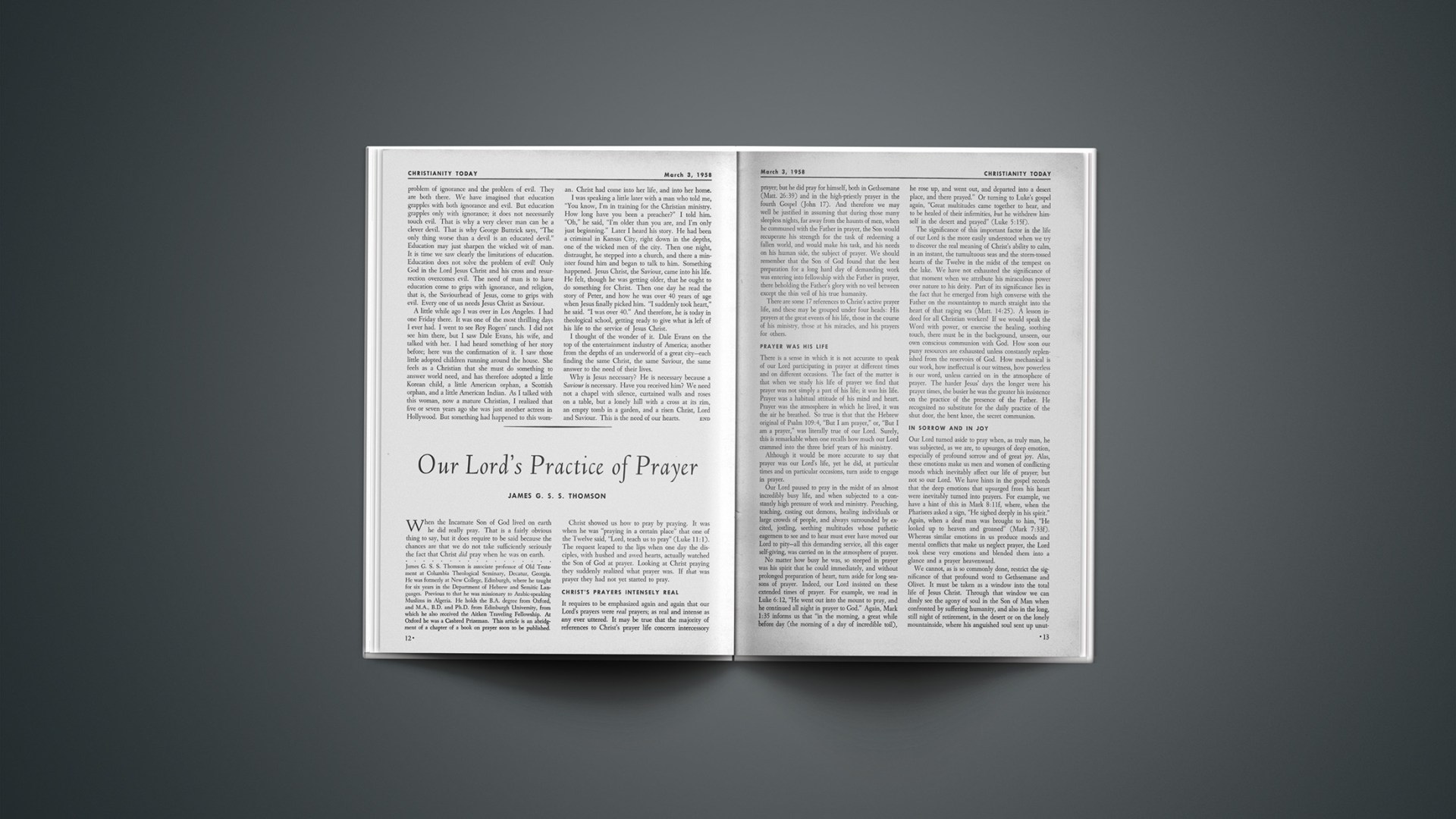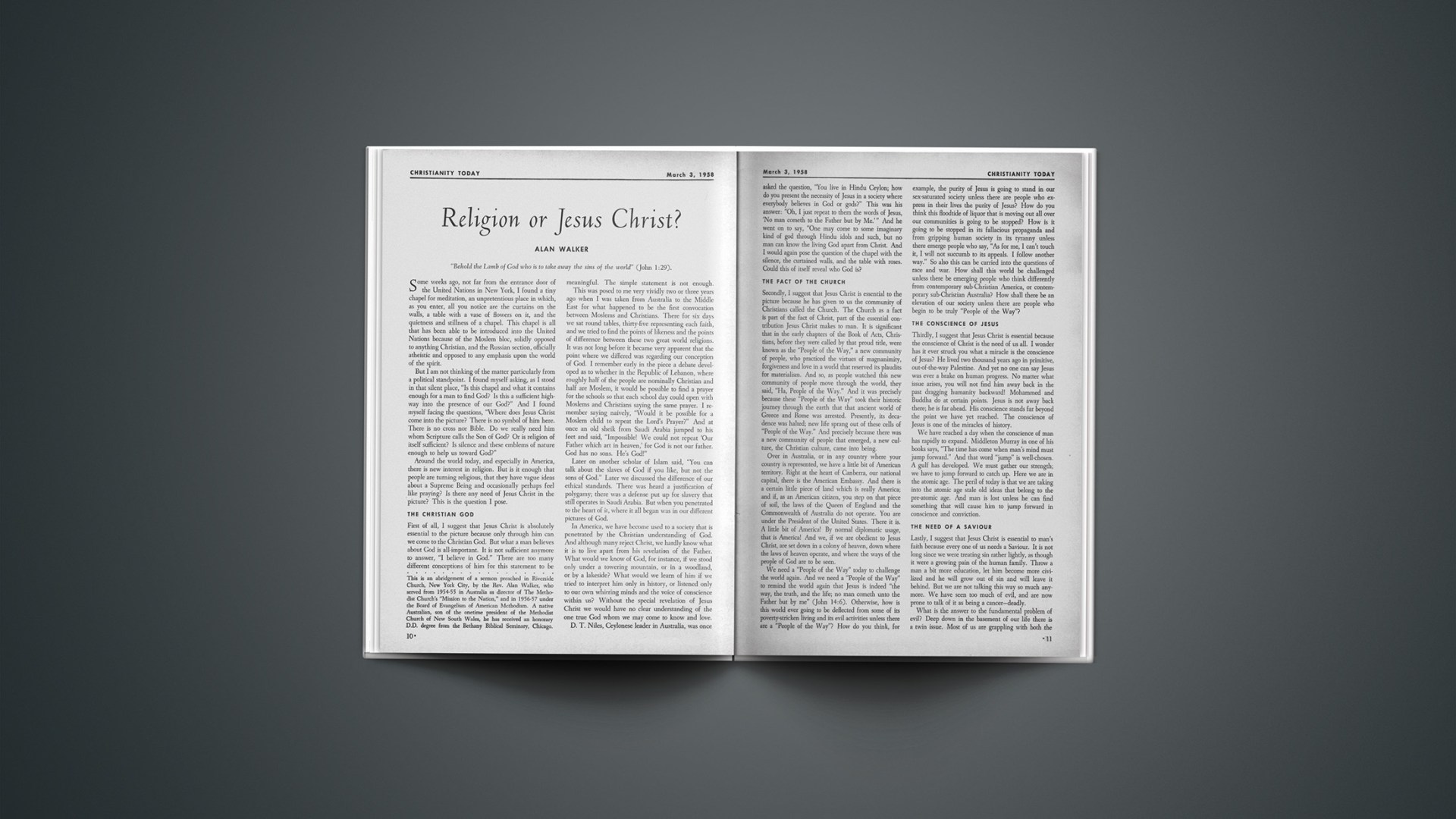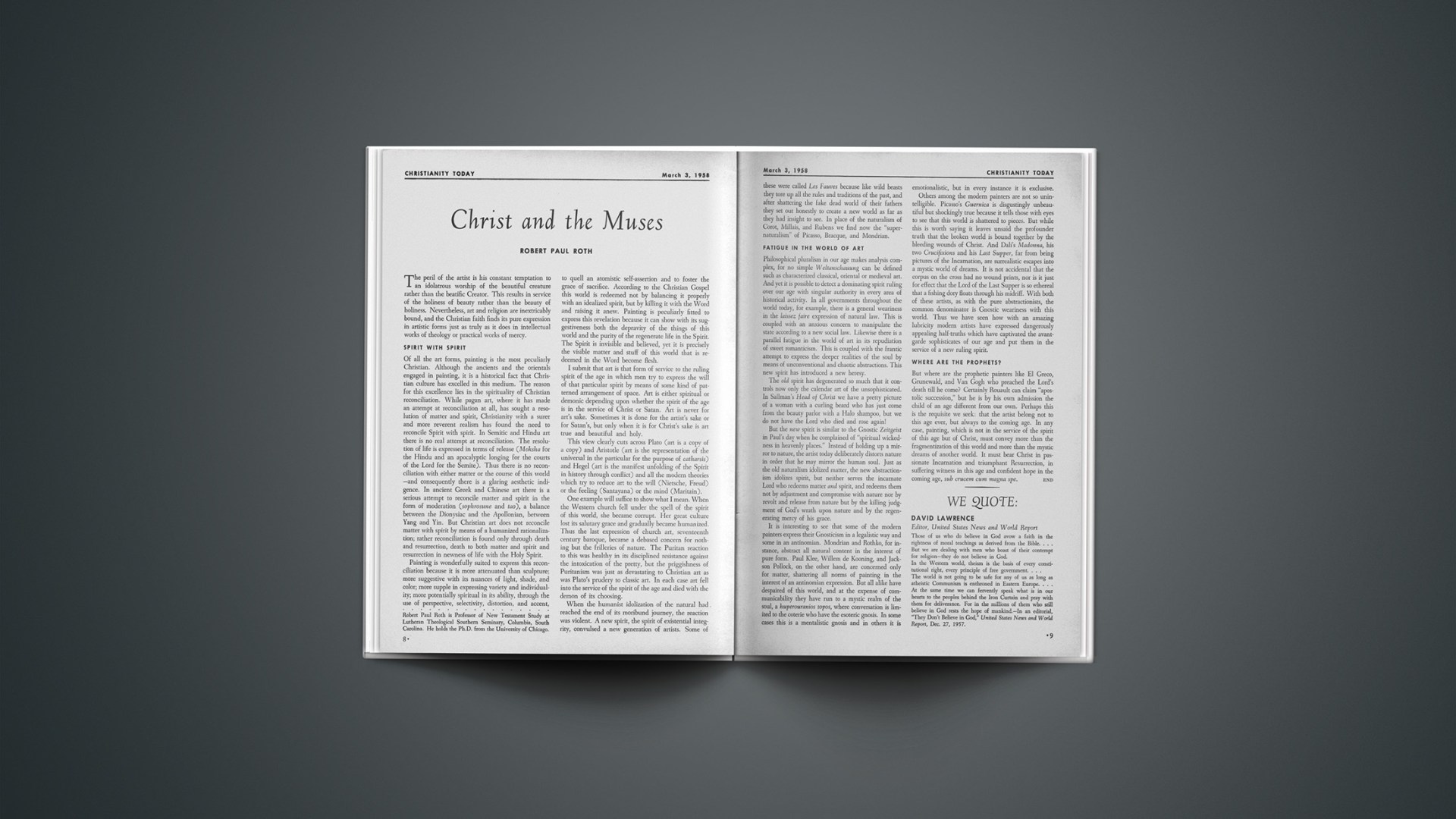Top government leaders met recently in Washington’s Mayflower Hotel for the sixth Presidential Prayer Breakfast with delegates of International Council for Christian Leadership, sponsoring group.
Many Americans interpret this annual gathering as a wholesome recognition of the need for national dependence upon God.
Host this year of the event which brings together members of Cabinet, courts, and Congress, along with other leading government officials, was William C. Jones, owner-manager of W. C. Jones Intertype Service of Hollywood.
Due to a raspish cold, President Eisenhower was indisposed and unable to attend the breakfast. Senator Frank Carlson of Kansas, president of ICCL, presided, and taking part were Secretary of the Army Wilbur M. Brucker, Senator John Stennis (Miss.), Supreme Court Justice William Brennan, and Secretary of the Treasury Robert B. Anderson. A case of flu cancelled Texas Governor Price Daniel’s scheduled participation.
After Scripture reading, the main address was given by Charles E. Wilson, former head of the General Electric Co., now president of People-to-People Foundation, Inc.
Mr. Wilson noted that wrong has triumphed for a time in too many parts of the world. “But God has not abdicated.… It may even be that the world will have to suffer yet more before men feel as they should their utter dependence on God.” Toward a solution of world problems, Wilson offered facilities of his organization to arrange an international forum for the frank exchange of views, each participant speaking as a human being rather than as a member of a government-team.
Nixon Asks Dedication, Sacrifice
Vice President Richard Nixon held out hope that certain minimal clothing and housing standards for the peoples of the world may be met, and that the conference table rather than the battlefield could provide the arena for solution of the world’s problems. We will meet the challenge successfully, he said, provided “we have the same dedication to our principles, the same willingness to sacrifice, as have the Communists.”
ICCL’s two-day convention followed the breakfast. This organization promotes breakfast and luncheon groups among government, business, and industrial leaders in this country and abroad to apply Christian faith to daily life. While its international program has been predicated upon a rather broad theological base, it has attracted a nucleus of leaders aware that the world crisis is fundamentally spiritual, and that Christianity holds a decisive key. Re-elected president this year, was Judge Boyd Leedam, chairman of the National Labor Relations Board and former chief justice of the South Dakota Supreme Court.
In America, as elsewhere, the movement’s evangelical vitality depends somewhat upon its zone of operation. Primary emphasis falls upon personal devotion and spiritual growth rather than discussion and development of specific social programs.
Broad counsel prevailed, for example, in the luncheon address of Under Secretary of Commerce Walter Williams who found leadership in being informed, taking personal action, and doing all with humility. Christ was represented as “perhaps” the most humble of men, and Jews were enjoined to apply their own religion practically.
For Religion as Practical Force
Lt. Gen. M. H. Silverthorn, USMC (Ret’d.), stressing religion as a practical force, pointed up Joshua, Gideon and David as men through whom God worked. Four rules for modern-day men of God included church attendance, lay action, Bible study, and “to love mercy and walk humbly.”
Director of the Worldwide Evangelistic Crusade, Norman Grubb of England, next morning gave an inspiring devotional on the believer’s mystical union with Christ, its secret being found in receiving life from Christ by virtue of his sacrifice for us.
In panel talks that followed, Senator Carlson mentioned that Pope Pius had heard of his lay work with ICCL and had prayed God’s blessings on it.
Richard C. Halverson, Associate Executive Director of International Christian Leadership, spoke with fervor on the challenge of the Far East. Despite the multitude of religions there, he made clear that the Orient’s solitary hope is Christ. Vague beliefs in God are insufficient. Yet Asia, he emphasized, is largely without Christ. It is not really anti-American or anti-West; its greatest threat is not Communism but secularism. Personal evangelism by Asians is the sole hope for reaching the vast populations.
A German Bundestag member, G. A. Gedat, reported in similar vein for Africa, while communist agitators are widespread, the continent is more or less lost in secularism. The greatest missionary obstacles are the fighting among church groups in Africa and the lives of so-called Western “Christians” resident there. (From Finland came the report that the Finns fear Hollywood more than Moscow.)
At the international luncheon, Roland Michener, Speaker of the Canadian House of Commons, commented on the admirable relations between Canada and the United States, eminently desirable, inasmuch as in accordance with the doctrine of the brotherhood of men that “we’re all sons of God.” Lt. Gen. Clovis Byers reported from NATO headquarters in Paris that the leadership of Christ will enable continuation of the difficult fight against Communism.
The final evening brought another challenge to face international issues. Dr. Bob Pierce, president of World Vision, Inc., centered his challenge in individual response. God has allowed the present perils of history to bring mankind to an end of itself; each individual, if he would act vitally and significantly in the crisis, must surrender and “let God be God” in him. The fact that one can’t do everything is no excuse for not doing something.
Judd Points Up Problems
Congressman Walter H. Judd (Minn.) declared today’s challenge to be the same as the apostolic one—to be witnesses in all the world (Acts 1:8) and thus serve the world. Man has “a part of God in him” and survival is necessary if he is to grow into the image of Christ.
The big problem of free-world statesmanship today, continued Judd, is “how principled people can deal with unprincipled people and still keep their principles.” The international situation is fraught with dilemma. How can we support the West without losing the East? Russia will be on the way to victory if she can get us to abandon “God’s children in the satellites.”
Mr. Judd opposes a summit conference at the present time, pointing out it sometimes does hurt to talk, such as in the two years at Panmunjom while Russia developed the H bomb. Continued concessions by the West at these conferences amount not to peace but “surrender on the installment plan.” Open covenants are good but, Woodrow Wilson to the contrary, they should not be openly arrived at.
“Jerusalem’s destruction can be ours unless we awake,” Congressman Judd warned. Man’s physical needs are important but he is too sick to be patched up with superficial plaster. His need is nothing less than “the Cross and the Saviour.”
Throughout the conference, leaders shared a profound concern, and voiced agreement that the Christian outlook is the world’s only hope. However, it was disconcerting, even distressing, to note the generous disagreement as to how the Christian outlook and the Christian hope were defined in the successive addresses and panel discussions. Dominant personalities tended to overshadow inconsistencies of thought. What held together ICCL’s rather disjunctive convention was not so much a common theological vision as a common sense of need and an uncommon measure of charity.—F. F.
Burden Of Truth
New impetus for resolving race conflicts in American life sparked the National Conference for Human Rights under auspices of the State of Pennsylvania and the United Steelworkers of America on Feb. 3 in Philadelphia. Some 200 leaders in business, labor and religious and community life heard Governor George M. Leader emphasize his state’s tradition of tolerance reaching back to William Penn, and Union President David J. McDonald’s grateful flourish that steel unions are free of racial tensions. Mr. McDonald voiced the ambition that the workshops of America may become the classrooms of democracy.
Participants premiered “Burden of Truth,” a film dramatizing the race problem, and urged its projection coast-to-coast through established organizations and institutions as a means of sensitizing American conscience. The 67-minute effort dramatizes racial evils, depicting a Negro who accepts the national emphasis on freedom and democracy but whose pattern of life is a shabby materialization.
A moving presentation, the film halts short of specific solutions, but expertly focuses the problem without narrowing it to the South. Its weakness is that in the main characters, college graduates of marked ability, American communities will not recognize the average Negro family in their midst. Nonetheless, it deals commendably with an evil which, numerically at least, is America’s biggest social problem of the day.
Although the film halted short of specific solutions, President McDonald did not withhold a particular program. He called on the National Association of Manufacturers and the National Chamber of Commerce and their local bodies to “speak out firmly and give their support for compliance with the Supreme Court’s ban on segregation, for fair practices in employment and in housing and in support of legislation which will guarantee all Americans equal protection under the law.” Then he outlined “what I believe to be labor’s role in this field.” In swift succession came particulars of a million-dollar-a-year scholarship reservoir to widen educational opportunities without regard to creed, color or origin; of labor representatives to NATO nations as ambassadors of good will; of a cooperative program with industry for upgrading qualified employees without race prejudice; of expanded opportunities for union leadership by minorities; of equal protection and justice for all citizens under the law; of support for federal aid and finance for additional aid to education and equal educational opportunities; of support for a program to abolish slums and provide low-cost and middle income homes.
Discussion groups followed addresses by Governor Leader, President McDonald and Joseph J. Morrow, personnel director of Pitney-Bowes Inc. Spokesmen were not content simply to consider means of extending the film’s use. Steel Union President McDonald’s connection of federal aid for education and housing with the discussion of racial integration was noted, as well as publicity given the conference as for the narrower purpose of integrating the Negro into the nation’s labor force (hence with a special eye to the South). If the film is to imply these particular solutions when shown throughout the land, one participant remarked, it holds “as much potential for dividing public sentiment as for unifying sentiment on the race problem.” Section leaders urged that the film not be attached to particular solutions, but that it be employed rather “to create a climate of local conviction” for challenging and meeting the problem.
In one section, Nelson Rockefeller emphasized that “the sense of national purpose” must be quickened if racial conflicts are really to be reselved. Dr. Clyde W. Taylor of National Association of Evangelicals reported his section’s conviction that emphasis on human duty must not be neglected alongside the emphasis on human rights. Dr. Carl F. H. Henry, editor of CHRISTIANITY TODAY, noted the “risk involved in facing this grave social evil apart from a firm interest in the larger problem of moral principles of permanent validity.” Even the interest in human rights “can be used” to promote specific organizations and programs, he cautioned, unless the nature of the moral order is clarified, and all men and social groups are viewed under God’s command and judgment.
From East To West
On the sixth ballot, electors of the California Episcopal Diocese chose as their next bishop coadjutor the Very Rev. James A. Pike, dean of New York’s Cathedral of St. John the Divine.
Here is a biographical digest of the 44-year-old clergyman:
—Author, lawyer, television personality.
—Raised in Roman Catholicism, turned agnostic, subscribed to tenets of Protestant Episcopal Church a year before ordination.
—Married twice, the first union having ended after two years in ecclesiastical annulment.
—Former counsel for Securities and Exchange Commission, War Shipping Administration; one of the youngest men ever to practice before United States Supreme Court.
—Onetime chaplain and head of department of religion at Columbia University; taught at George Washington and Catholic universities.
—Schools attended include University of Santa Clara, UCLA, USC, Yale and Virginia, General and Union theological seminaries.
What Is Your Religion?
Proponents of religious census questions point to the results of a voluntary response survey as evidence of the value of such government polls.
The Census Bureau had already announced it would not include a question on religion affiliation in the 1960 census when it came up with figures gleaned from a sample survey made a year ago. The survey among 35,000 households in 330 areas across the country obtained answers to the question “What is your religion?” on a voluntary basis. It was the first time the bureau had asked such a question in a nationwide sampling. Church membership data previously had been secured by the bureau from religious organizations.
The new census report shows that of every three persons 14 years old and over in the United States, two regarded themselves as Protestant, and one out of every four as Roman Catholic.
The results indicated those who would refuse to answer the question on religious affiliation constitute only nine-tenths of one per cent of the population.
Statistics are estimates and include only persons 14 years old and over:
Protestants 79,000,000; Roman Catholics 30,700,000; Jewish 3,900,000; others 1,500,000; no religion 3,200,000.
Baptist 23,500,000; Methodist 16,700,000; Lutheran 8,400,000; Presbyterian 6,700,000.
About 83 per cent of the South was reported as Protestant, 69 per cent of the West, 69 per cent of the North Central region, and 42 per cent of the Northeast. The 45 per cent of Roman Catholics in the Northeast was the largest reported group in any region.
Because the survey sought out affiliation rather than church membership or even church attendance information, the results were not directly comparable to claims by denominations. The estimate cited for Methodists is nearly twice as high as that claimed by the denomination. The national Jewish estimate is about 10 per cent below that of official Jewish bodies.
Mixed marriages are much more common among Roman Catholics than among Protestants and Jews, but 94 per cent of couples are of the same faith. Catholic families are not larger than Protestant ones. A detailed report of the sample survey is available for 10¢ from the Bureau of the Census, Washington 25, D.C.
Time In Hand
National Religious Broadcasters are maneuvering to establish a headquarters office utilizing a full-time executive director.
Details of the move, the gospel program sponsors decided at their 15th annual convention in Washington, will be worked out at another NRB meeting to be held in conjunction with the National Association of Evangelicals convention in April.
The 120 delegates to the Washington conclave tussled anew with the problem of paid vs. free broadcasting. Some feared a trend to more radio time for music, news and sports, to the exclusion of gospel programs even when sponsors are willing to pay.
NRB opposes free time because too often it is meted out to the advantage of church councils unsympathetic to the evangelical cause.
The possibilities of counter-pressures by the evangelical constituency was suggested during a spirited question-and-answer session following an address to the convention by Harold E. Fellows, president of the National Association of Broadcasters (which with a membership of 2,000 radio and TV stations, plus all major networks, represents the voice of the broadcasting industry in the United States).
To be sure, there are pressures antagonistic to conservative theology. But could not public demand also constitute a pressure, one that could influence station managers to see evangelical broadcasts as desirable?
There was also the consideration that radio stations are business, that they are after programs which will bring maximum return on the dollar.
In some respects the problem came back down to the individual broadcaster. If he can gain a wide enough audience, he has a good case. And to do this, there may be the need for more effective programming, for higher standards of production, for even a greater sense of responsibility.
Working for NRB is a strong mutual feeling of determination. The tone of debate gave the impression that here was a force more than able to meet the problem. The decision to move ahead to fulltime headquarters offered evidence that the problem could be solved.
Europe
Ecumenical Decisions
The 12-member World Council of Churches Executive Committee has taken a significant step toward possible establishment of relations with the Russian Orthodox Church.
At a semi-annual meeting in London the committee agreed to a meeting between officials of the two groups in August. The action came at the suggestion of the Moscow Patriarchate, but no arrangements were announced as to the site of the proposed meeting.
Dr. Franklin Clark Fry, chairman of the Executive Committee, said “it is assumed that the meeting will be of the nature of a first exploratory consultation to exchange information and get acquainted.”
The Executive Committee’s action was in line with a previous decision of the World Council’s Central Committee approving “conversations” with the Russian church. Originally the conversations were scheduled for January, 1957, but they were delayed at the request of the Moscow Patriarchate.
Other committee business included a report from Dr. W. A. Visser’t Hooft, general secretary of the WCC, on the status of Protestant churches in Eastern Europe.
Forced resignation of Dr. Lajos Ordass as presiding bishop of the Hungarian Lutheran Church, said Dr. Visser ’t Hooft, is an example of increasing pressure from the communists. Dr. Ordass was at one time a member of the WCC’s Central Committee.
The general secretary characterized relations with the churches in Eastern Germany as “the most difficult problem of the last few months.” He cited recent refusals of the East German government to grant visas to churchmen to attend conferences in other countries.
The committee also (1) recommended to its Central Committee that the Third Assembly of the World Council of Churches scheduled for Ceylon in 1960, be delayed for one year “in order that churches and national Christian councils have more time to consider details of the World Council of Churches-International Missionary Council merger” and (2) decided that the Council’s proposed religious liberty study should be “worldwide.”
Japan
Bows Stir Christians
Japanese pastors in Kobe challenged the action of a school principal in teaching sixth grade pupils how to bow to Shinto.
The Christian Ministers Association of Kobe submitted a fully-documented protest to the Department of Education in Tokyo and to the Kobe Educational Committee.
The protest charged that the practice violated the Japanese Constitution. Pupils were taught the official act of worship to be performed on an excursion to the Shrine of Ise (Shinto), the protest said.
According to the protest, the ceremony was actually performed at the shrine by all except three Christian pupils who refused to bow.
The incident brought up the question of whether the government officially considers such shrines as religious or cultural. The protest claimed that shrines are legally considered religious.
The Rev. Teruichi Matsuda, pastor of the Nagata Reformed Church, spearheaded the protest. He followed up the action by personally confronting a Department of Education official, Iwao Utsumi, who reportedly refused to spell out the government’s attitude toward Shinto worship.
The pastors’ protest failed to win the support of the Japanese Association of Christian Schools, which indicated fear that resulting agitation would increase attendance at shrines.
Worth Quoting
“In spite of their great differences and widespread liberalism, the Protestant churches show promise of a doctrinal revival that is quite unique in American history. Their current interest in promoting religious education in the public schools, the success of the ecumenical movement in stemming the tide of sectarianism, the steady increase of church membership in conservative bodies, and the popularity of biblical evangelists like Billy Graham are symptomatic of an improvement which Catholics may honestly praise. For we realize that the more dogmatically vital is the atmosphere in which our people live, the more secure is their faith and the more will American Catholicism prosper.”—The Rev. John A. Hardon, S.J., Professor of Theology at at West Baden University, West Baden Springs, Indiana, in an address before the Society of Catholic College Teachers of Sacred Doctrine, in St. Louis.
“Dull, unexciting religion has emptied the churches of Europe since the beginning of this century and it will do it for you in America before the century closes unless you are very careful.
“The Bible says there is rejoicing in the presence of the angels over one sinner who repents. The modern church needs to ask God’s forgiveness that it has afforded Him so little cause for rejoicing.
“I have watched your country for a whole generation. I can see in the church life of America precisely the same symptoms I could see in the church life of my own country when I began my ministry (in 1924).
“We had better heed the voice of God.”—Dr. Norman G. Dunning, Warden of Haworth Hall, Kingston Upon Hull University, Lancashire, England, at preaching mission in the First Presbyterian Church, Columbia, S. C.

